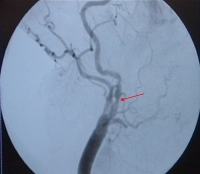Neurological clinical examination
- >90% of stenoses and occlusions of supraaortic vessels (ICA, vertebral artery, etc.) remain clinically asymptomatic and are incidental findings during screening examinations or preoperative imaging studies
- Symptoms of a lesion in the vessels supplying the brain depend on the vessel involved, the course over time, and the prevailing collateral blood supply ( e.g., via the cerebral arterial circle)
- Typical symptoms of impaired blood flow in the area supplied by the carotid artery (internal carotid artery) are:
- Motor or sensory hemisyndrome (e.g. "hemiplegia")
- Amaurosis fugax (transient unilateral blindness: opthalmic artery)
- Cortical dysfunction (language, visuospatial perception)
- Homonymous bilateral visual field deficits are usually not a typical symptom of internal carotid artery stenosis
- Important: Carotid artery auscultation is inadequate for stenosis detection!
Color flow Doppler imaging
Ultrasonography of the extracranial vessels supplying the brain should always study all vessels in both the transverse and axial plane:
- Common carotid artery from proximal to carotid bifurcation
- Carotid bifurcation with the posterolateral origin of the ICA
- External carotid artery
- Segments V1 to V3 of vertebral artery
- Subclavian artery and axillary artery
Search for hemodynamically relevant plaques and their morphological description ( B-mode):
- Hyperechoic versus hypoechoic
- Homogeneous versus inhomogeneous
- Smooth versus irregular contour
Plaque parameters with unfavorable prognosis:
- Hypoechoic internal plaque structure
- Extended plaque >1 cm
- Plaque diameter >4 mm
- Axial pulsation of the distal plaque
By international agreement, stenoses should be quantified according to the NASCET criteria.
Contrast-enhanced MR angiography or alternatively, CT angiography
- Validation of the findings or for treatment planning
- Assessment of intracranial vessels and possible parenchymal lesions (prior cerebral infarctions)
Digital subtraction angiography (DSA) of the arteries supplying the brain
- Only if the noninvasive procedures have proved inconclusive resulting in therapeutic consequences
- Example: stenotic kinking not evident on MRI or CT scan
CT or MRI of the brain
- In symptomatic patients, parenchymal imaging prior to elective revascularization
- In asymptomatic patients, such imaging can provide important additional insight, e.g., evidence of clinically silent cerebral infarction
Chest x-ray
Laboratory panels
- Blood count
- Electrolytes
- Coagulation
- Kidney function parameters
- Liver function parameters
- Blood lipids
- Blood group
In all patients with arteriosclerotic carotid stenosis, other sequelae of arteriosclerosis (coronary artery disease [CAD], peripheral arterial occlusive disease [PAOD]) should be assessed!
